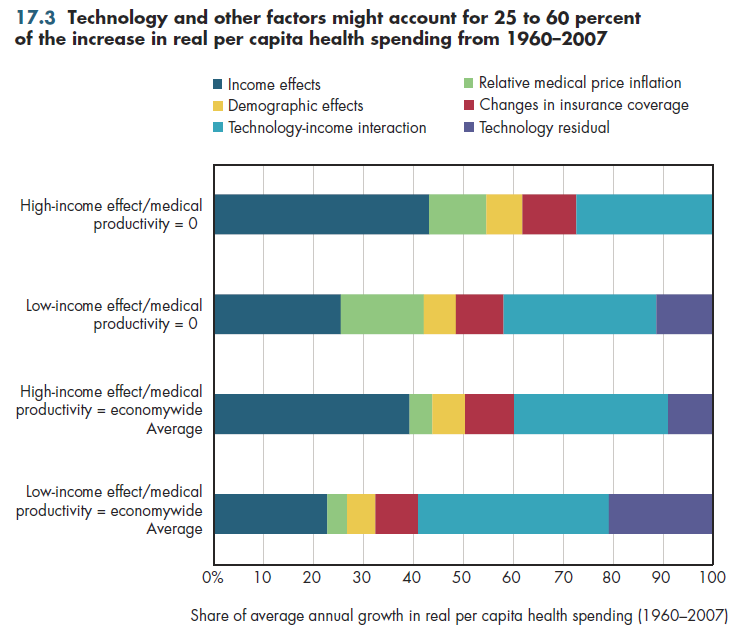Download PowerPoint versions of figure.
Inside Collection (Book): American Health Economy Illustrated
17.3 Technology Has Been An Important Driver of Health Spending
Summary: Technology has been an important driver of health spending. However, measuring its precise role has been difficult.
Technology accounts for as much as 25 percent to 60 percent of the rise in real per capita health spending from 1960 to 2007. It is impossible to be more precise about technology's role because it is not feasible to measure price changes accurately enough to distinguish between pure price changes and changes in the quality of the health care good or service being sold. This makes it difficult to determine how much of rising health costs is due to actual changes in output versus higher prices. Economists have resorted to trying to bound this uncertainty using different assumptions. For example, if there are zero changes in productivity, then it is easy to calculate changes in output based on measuring changes in inputs.
Another important factor driving health spending is that as incomes increase, the inclination to use health care appears to increase. This greater demand occurs not only in terms of the use of health services but also in terms of the quality of care. Experts disagree on how much increase in demand for medical services can be expected for every $1,000 increase in per capita income.
Figure 17.3 shows the impact of various assumptions about these issues. Using high-impact assumptions about rising incomes and demand for health care and conservative assumptions about productivity growth, that is, zero, the estimated magnitude of the role of technology in driving health spending is the smallest. Using the opposite assumptions about income and productivity growth (that is, that productivity grows in step with productivity trends in the general economy), the role of technology appears much larger.

Under any of these assumptions, rising medical prices account for only approximately 3 percent to 15 percent of rising real per capita health spending. Despite the aging of the U.S. population, demographic factors likewise account for only 3 to 6 percent of rising health costs. In contrast, expanded insurance coverage accounts for a relatively larger share of the change in real per capita health spending than either of these other two factors. Some experts assign a far larger role to health insurance due to ample evidence that it drives decisions to acquire and use new technology.
Downloads
References
- Smith S, JP Newhouse and MS Freeland. Income, Insurance, And Technology: Why Does Health Spending Outpace Economic Growth? Health Affairs 2009; 28(5):1276-84.
Collection Navigation
- « Previous module in collection 17.2 How Price of Treatments Changes over Time Depends on How Innovations Are Measured
- Collection home: American Health Economy Illustrated
- Next module in collection » 17.4 Whether Social Burden of Illness Has Increased or Decreased Depends on How It was Measured
Content actions
Give feedback:
Download:
Add:
Reuse / Edit:
Twin Cities Campus:
- © 2012 Regents of the University of Minnesota. All rights reserved.
- The University of Minnesota is an equal opportunity educator and employer. Privacy
- Last modified on Sep 24, 2013 4:17 pm -0500









